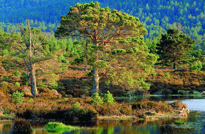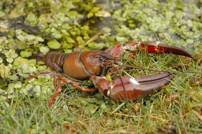As part of our spotlight on Biodiversity, our blog recently featured two new biodiversity information and data resources that are now available on Scotland’s environment website – Habitat Map of Scotland (HabMoS) and Ecosystem Health Indicators. But we have much more information and data to help your understanding of Scotland’s valuable biodiversity and influence new actions for its care and restoration.
Scotland's environment web
October 31, 2017
Biodiversity is important to our environment
Woodlands and forests
Scotland’s woodlands and forests support a wide range of important plants and animals. Forests are extensive areas dominated by trees, while woodlands are often smaller elements of a landscape where open space is dominant.

(Image: Caledonian pinewood at Rothiemurchus, Cairngorms © Copyright Lorne Gill, NatureScot)
Landscape scale conservation
Find out more about projects involving communities, land managers and other partners that are working to address biodiversity issues and deliver socio-economic benefits.

(Image: Kinneil Lagoons, Inner Forth © Copyright Ian Kirkman)
View biodiversity data in your area
Use the new search function ('Add Map Data Layers') on Scotland’s environment map tool to find and view biodiversity spatial data published by our partners. Take a look at data such as Special Areas of Conservation, Sites of Special Scientific Interest, Wetlands of International Importance, Habitats (HabMoS), Biosphere Reserves, Caledonian Pinewood, Ancient Woodland and Species Conservation, to name but a few.
Explore your area and the biodiversity species have been observed and recorded on the NBN Atlas Scotland – part of Scotland’s environment network of trusted data portals.
Improving the condition of protected nature sites
The condition of protected nature sites is a Scottish Government national performance indicator and Scotland’s Biodiversity – a route map to 2020 priority area for action.
Sites are designated as protected either for their plants, animals or habitats, their rocks or landforms, or a combination of these. Together they form a network of the best natural features throughout Scotland; from the moss heaths on the highest summit, Ben Nevis, through lowland species-rich grasslands and raised bogs, to the seas around Scotland, such as marine reefs of Loch Maddy in the Western Isles.
Designations of protected sites include:
Forvie National Nature Reserve in Aberdeenshire has several designations attributed to it. These include Special Protection Area, Special Area of Conservation, Special Site of Scientific interest, Ramsar, and Local Special Protection area.
NatureScot publishes data that you can view in our protected nature sites data analysis tool – providing a visual analysis of the condition of Scotland’s most important nature sites.
You can use the application to search by habitat type (such as woodland, upland, wetlands), by species type (bird, plants, mammals), within a local authority or national park, by the condition of features of by a single group of sites. The application presents the sites selected on an interactive map, along with current condition, the pressures on condition and historic trends.
Pressures that impact on biodiversity loss
Scotland’s Biodiversity – route map to 2020 identified the spread of invasive species and a key pressure on biodiversity. Non-native species are animals or plants that have been introduced into an area in which they do not naturally occur. We need information on where invasive non-native species occur, especially new arrivals in Scotland, to support management including biosecurity and, in some cases, eradication.
Find out more about non-native species of concern

(Image: North American Signal crayfish (Pacifastacus lenisculus) © Copyright Trevor Renals)
Get involved - record what you see
A high proportion of biodiversity observation data is collected by volunteers and citizen scientists. Environmental agencies responsible for collating environmental data can’t be all places at all times, so getting involved and helping to record your own observations can help to extend monitoring networks all over Scotland. There are lots of ways you can submit your own biodiversity data observations and Scotland’s environment web has some recommendations for you:
Adobe Acrobat Reader is the free, trusted leader for reliably viewing, annotating and signing PDFs.
Download Adobe Acrobat Reader



